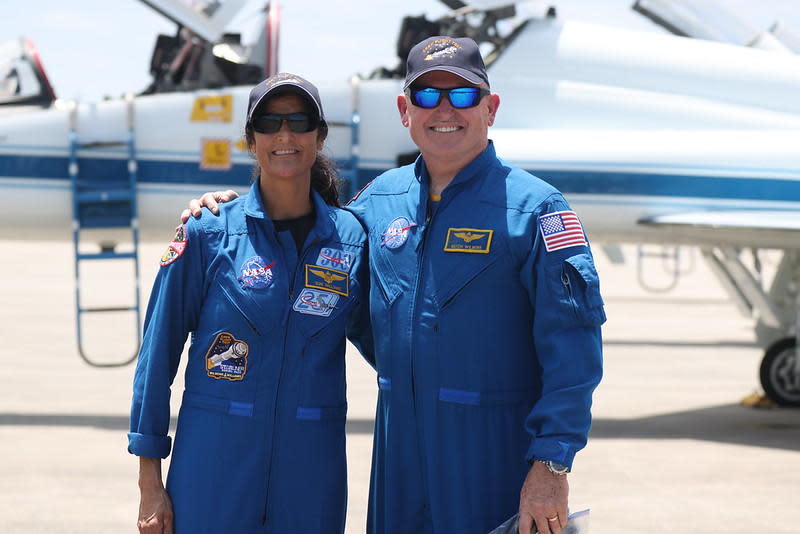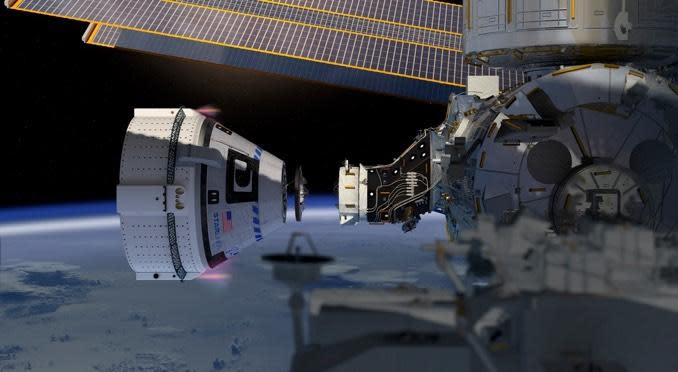Two veteran astronauts flew to the Kennedy Space Center Thursday afternoon to prepare for the first piloted launch of Boeing’s Starliner spacecraft, a long-awaited flight running years behind schedule after two uncrewed test flights and extensive work to resolve a variety of technical problems.
Astronauts Barry “Butch” Wilmore and Sunita Williams, two of NASA’s most seasoned astronauts with four previous spaceflights, 11 spacewalks and 500 days in orbit between then, landed at the spaceport’s 3-mile-long runway in T-38 jet trainers after a flight from the Johnson Space Center in Houston.


“We love Florida. We love the Kennedy Space Center, because this is where you launch humans into space,” an ebullient Wilmore told reporters on the runway. “In less than two weeks, the next flight we take we’ll be laying on our backs and (launching) into the heavens.”
Completing the Starliner’s Crew Test Flight, or CFT, will “broaden (NASA’s) capability to and from space station, and that’s vitally important,” he said. “We’re excited to be here.”
Said Williams: “This is where the rubber meets the road, where we are going to leave this planet, and that is pretty darn cool!”
A few hours after the crew arrived, and shortly after two Russian cosmonauts completed a four-hour 36-minute spacewalk outside the International Space Station, mission managers completed a two-day flight readiness review, tentatively clearing the Starliner for launch atop a United Launch Alliance Atlas 5 rocket at 10:34 p.m. EDT on Monday, May 6.
If all goes well, Wilmore and Williams, both former Navy test pilots, will dock at the space station on May 8 and return to Earth May 15 or shortly thereafter. If the mission goes well, NASA plans to begin operational Starliner crew rotation flights in 2025, alternating crew launches with SpaceX.
“Today was a was a huge day for our Commercial Crew Program,” said Steve Stich, manager of the CCP for NASA. “All the (international) partners and then our whole team polled ‘go’ to proceed to the launch on May 6. Not only that, but we (signed) what we call an interim human rating for Starliner for this crewed flight test. … It was a was a huge deal for NASA and our entire team.”


NASA awarded two Commercial Crew Program contracts in 2014, one to SpaceX valued at $2.6 billion and the other to Boeing for $4.2 billion, to spur development of independent spacecraft capable of carrying astronauts to and from the International Space Station.
The goal was to end reliance on Russia’s Soyuz in the wake of the space shuttle’s retirement and to resume launching American astronauts from U.S. soil aboard American rockets and spacecraft. Equally important to NASA is having two independent spacecraft for crew flights to the ISS in case one company’s ferry ship is grounded for any reason.
SpaceX kicked off piloted flights in May 2020, successfully launching two NASA astronauts on a Crew Dragon test flight to the space station. Since then, SpaceX has launched 50 astronauts, cosmonauts and civilians to orbit in eight operational flights to the lab complex, three commercial visits and one privately-funded flight to low-Earth orbit.
Boeing launched its Starliner on an unpiloted test flight in December 2019, but the spacecraft experienced major software and communications problems that combined to derail an attempt to dock with the space station and almost led to the crew ship’s destruction.
A second unpiloted flight was ordered (and paid for by Boeing), but during an August 2021 launch window engineers discovered corroded valves in the spacecraft’s propulsion system. Fixing that problem delayed the second test flight to May 2022.
While the mission was successful, additional problems were discovered, including parachute issues and concern about possibly flammable protective tape wrapped around internal wiring. Correcting those problems, and finding room for a visit in the space station’s complex flight schedule, eventually delayed the Crew Flight Test to May 6.
Given recent problems with Boeing aircraft that have raised questions about the company’s safety culture, a successful Crew Flight Test is seen by many as a critical milestone, both for Boeing and for NASA’s Commercial Crew Program.
For his part, Wilmore said he didn’t view the Starliner launch in the context of Boeing’s widely reported aircraft issues.


“I don’t think it has necessarily anything to do with Boeing and a flight going off,” he said. “They’re all vitally important. This is human spaceflight. That adage you’ve heard since Apollo 13, failure is not an option? That has nothing specifically to do with Boeing or this program. That’s all the things that we do in human spaceflight.
“So, this one is no more or less important than anything else we’re doing,” he said. “It just happens to be the most important one we’re doing right now.”
Mark Nappi, Boeing’s Starliner program manager, agreed, saying “the success of this mission has always been very important for us as a program for a lot of reasons.”
“Number one, we have humans flying on this vehicle,” he said. “We take that so seriously in human spaceflight. I’ve spent my career in this business, and it always has been the top of the list.
“Second is, this is an important capability for us, for NASA, and so we signed up to go do this, and we’re going to go do it and be successful at it. So I don’t think of it in terms of what’s important for Boeing as much as I think of it as in terms of what’s important for this program, what’s important to follow through with, the commitments that we made to our customer.”
U.S. Catholics and their relationship to the church
Pope Francis says “negotiated peace is better than a war without end”
Crisis at Pearl Harbor I Sunday on 60 Minutes
